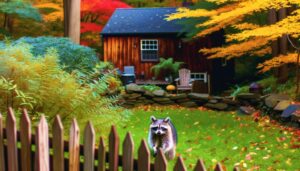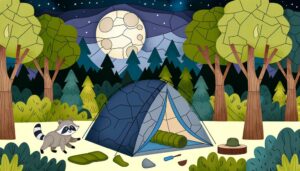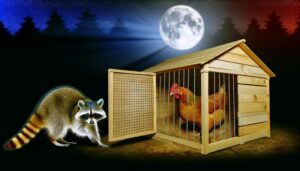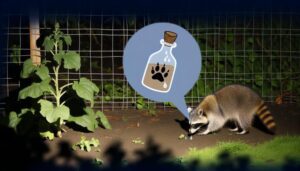How Do Raccoons Get Cold in Winter?
Raccoons possess several adaptations to withstand cold winter temperatures. They accumulate body fat, growing reserves that can increase by up to 50%, and dense fur provides effective thermal insulation.
Behavioral adaptations such as torpor, where they enter a state of reduced metabolic activity, and communal denning, which conserves heat, are essential. Raccoons also modify their foraging strategies, targeting high-fat and protein-rich food, and tend to reduce activity to preserve energy.
They seek shelter in various natural and urban environments, including tree hollows and man-made structures. These strategies allow raccoons to survive winter's challenges efficiently.
Explore further to understand their remarkable adaptability.
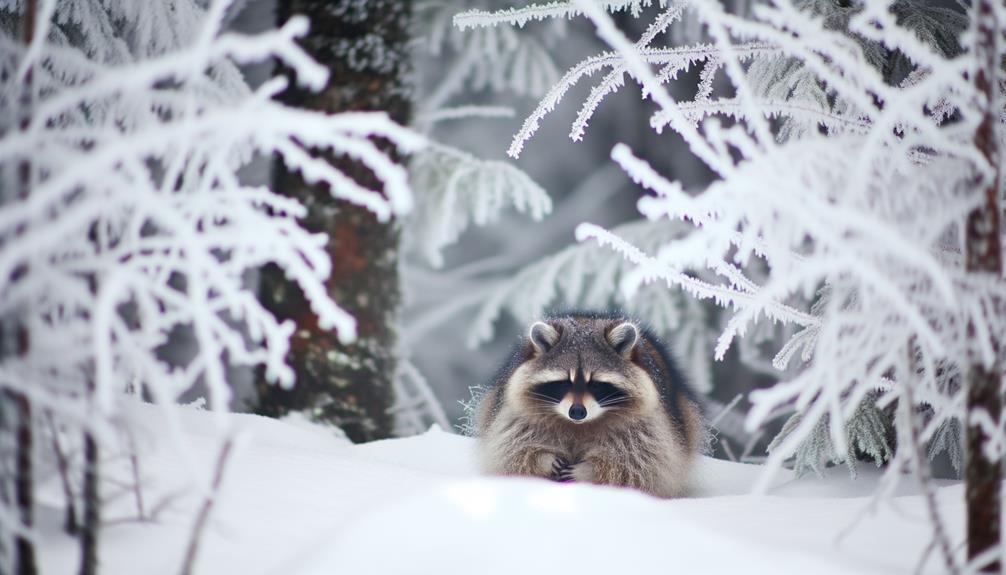
Key Takeaways
- Raccoons enter torpor, a state of reduced metabolic activity, to conserve energy during cold winters.
- They use communal denning to share body heat and stay warm.
- Dense fur and increased body fat provide insulation against the cold.
- Raccoons seek shelter in tree hollows, rocky crevices, and man-made structures to avoid the cold.
- Reduced activity and altered foraging patterns minimize energy expenditure in winter.
Raccoon Winter Behavior
Raccoon winter behavior encompasses a range of adaptive strategies. These include torpor, communal denning, and altered foraging patterns, collectively enabling their survival during colder months.
Field observations indicate that raccoons enter a state of torpor during winter. Torpor is marked by reduced metabolic rate and lower body temperature, helping them conserve energy.
Data analysis from various studies shows that communal denning is another key behavior. In communal denning, multiple raccoons share a single den. This provides mutual warmth and reduces individual energy expenditure.
Additionally, raccoons adjust their foraging activities during winter. They rely on cached food and opportunistic scavenging in multiple habitats.
These behaviors are critical for raccoons as they allow them to endure the challenges of winter without the need for true hibernation. This helps in maintaining their population resilience.
Adaptations to Cold
Several physiological and behavioral adaptations enable raccoons to withstand cold temperatures during winter months. Raccoons increase their body fat in autumn, providing insulation and energy reserves. Their dense fur, with a layer of soft underfur, offers exceptional thermal insulation. Behavioral adaptations include communal denning, where raccoons share dens to conserve heat. Reduced activity levels during extreme cold help minimize energy expenditure.
| Adaptation | Description |
|---|---|
| Increased Body Fat | Insulation and energy reserves |
| Dense Fur | Thermal insulation with soft underfur |
| Communal Denning | Sharing dens to conserve heat |
| Reduced Activity | Minimizing energy expenditure during extreme cold |
| Metabolic Adjustments | Lowered metabolic rate to conserve energy |
These adaptations are essential for raccoons' survival in harsh winter conditions, ensuring they remain resilient and healthy.
Finding Shelter
Raccoons employ various strategies to find shelter during the winter, utilizing both natural dens and urban environments to mitigate exposure to cold temperatures. Field observations indicate a preference for tree cavities, abandoned burrows, and attics in suburban areas, highlighting their adaptability.
Seasonal behavior changes, such as reduced activity levels and communal denning, further support their survival in colder months.
Natural Dens Usage
In preparation for winter, these nocturnal mammals exhibit a strong preference for natural dens such as tree hollows, deserted burrows, and rocky crevices to seek shelter from harsh weather conditions. Field observations and data analysis reveal that raccoons meticulously select dens that provide excellent insulation and protection. These dens not only help them conserve body heat but also offer security against predators and severe weather.
- Tree Hollows: Ideal for insulation and height safety.
- Deserted Burrows: Utilize existing structures to minimize energy expenditure.
- Rocky Crevices: Offer robust protection from wind and precipitation.
- Layering of Leaf Litter: Raccoons often line their dens with leaves to enhance insulation.
Urban Shelter Adaptations
Amid urban environments, raccoons exhibit remarkable adaptability by utilizing man-made structures such as attics, basements, and storm drains to find shelter during the winter months. Field observations indicate that raccoons prefer warm, dry spaces that offer protection from the elements and potential predators.
Data analysis of urban raccoon populations reveals a significant increase in the use of residential areas for denning, particularly in colder climates. These animals exploit the thermal insulation properties of buildings, reducing their energy expenditure for thermoregulation.
Additionally, raccoons demonstrate a high level of ingenuity in accessing these spaces, often entering through small openings or weakened structures. This behavior underscores their resilience and resourcefulness in adapting to anthropogenic landscapes for winter survival.
Seasonal Behavior Changes
Throughout the colder months, raccoons exhibit distinct seasonal behavior changes by seeking out insulated shelters to mitigate the effects of dropping temperatures. Field observations and data analysis reveal that these nocturnal mammals prioritize finding secure locations to maintain body heat and conserve energy. Typically, raccoons gravitate towards:
- Tree cavities: Naturally insulated, these provide protection from wind and predators.
- Abandoned burrows: Previously used by other animals, offering ready-made warmth.
- Human structures: Attics, barns, and sheds become critical refuges in urban environments.
- Dense vegetation: Thick underbrush and fallen logs serve as natural insulators.
These behaviors underscore the raccoon's adaptability and resourcefulness, ensuring their survival through adverse weather conditions.
Understanding these patterns can foster efforts to coexist harmoniously with raccoons, particularly in urban settings.
Dietary Changes
During winter, raccoons exhibit notable changes in their diet due to the scarcity of their typical food sources. Field observations indicate that raccoons adjust their caloric intake by consuming more energy-dense foods available during the colder months.
Additionally, shifts in foraging behavior are observed, with raccoons expanding their search range and altering their feeding patterns to optimize resource acquisition in response to seasonal variations.
Seasonal Food Sources
Raccoons exhibit significant dietary shifts in the winter months, primarily driven by the seasonal availability of food sources. Field observations and data analysis reveal that raccoons adapt their diet to optimize foraging efficiency and energy conservation.
During winter, their consumption patterns change as follows:
- Animal Protein: Increased reliance on small mammals and insects, which may be easier to catch in colder temperatures.
- Plant Matter: Reduced intake of fruits and nuts due to seasonal scarcity.
- Human Refuse: Greater dependence on scavenging urban waste as natural foods become less accessible.
- Water Sources: Preference for unfrozen water sources, essential for hydration and food processing.
These dietary changes reflect raccoons' remarkable adaptability and their ability to survive in varied environments during winter months.
Caloric Intake Adjustments
Significant caloric intake adjustments are observed in raccoons during winter, driven by the need to maintain energy reserves for thermoregulation and survival. Field observations and data analysis indicate that raccoons increase their caloric consumption in autumn to build up fat reserves.
This preparatory phase ensures they can withstand periods of food scarcity and cold temperatures. Their dietary shift includes a higher intake of high-energy foods such as nuts, seeds, and insects, which are rich in fats and proteins. These dietary changes are essential for sustaining their metabolic needs during the colder months.
Understanding these adjustments can assist wildlife conservationists in developing strategies to support raccoon populations through habitat management and food resource availability during winter.
Foraging Behavior Changes
As raccoons prepare for winter by increasing their caloric intake, their foraging behavior undergoes notable changes, shifting towards the consumption of more energy-dense foods. Field observations and data analysis reveal that raccoons prioritize high-fat and high-protein sources to build fat reserves essential for surviving colder months. This dietary shift is critical for maintaining body heat and energy levels when food becomes scarce.
Increased consumption of nuts and seeds: Rich in fats, these provide sustained energy.
Scavenging on carrion: Provides a reliable source of protein during lean periods.
Greater reliance on human refuse: Urban raccoons often exploit garbage for high-calorie leftovers.
Reduced foraging range: To conserve energy, they tend to forage closer to their dens.
These adaptations highlight raccoons' remarkable flexibility and resilience.
Fat Storage
To prepare for the colder months, a significant portion of a raccoon's energy intake is devoted to accumulating fat reserves. Field observations indicate that raccoons exhibit increased foraging activity in late summer and fall, consuming high-calorie foods like nuts, fruits, and small vertebrates.
Data analysis reveals that their body fat percentage can increase by up to 50% during this period. This fat storage is vital for thermoregulation and energy supply when food becomes scarce. By building these reserves, raccoons enhance their survival odds, effectively insulating themselves against the harsh winter temperatures.
This adaptive strategy underscores the importance of fat storage in maintaining not only individual health but also the stability of raccoon populations through seasonal fluctuations.
Activity Levels
In addition to accumulating fat reserves, raccoons also adjust their activity levels in response to the changing seasons. Field observations and data analysis indicate that these adjustments are essential for their survival in winter.
Raccoons often reduce their activity to conserve energy during colder months. This behavior is evident through:
- Decreased foraging frequency: Raccoons venture out less often in search of food, relying on stored fat.
- Extended periods of rest: Increased resting time in dens helps minimize energy expenditure.
- Altered foraging times: They may shift their activity to warmer parts of the day when temperatures are more tolerable.
- Seasonal den sharing: Raccoons sometimes share dens with other raccoons to retain body heat.
These adaptations highlight the raccoon's ability to endure harsh winter conditions effectively.
Predation Risks
During the winter months, raccoons face increased predation risks due to their reduced activity levels and the scarcity of available cover. Field observations indicate that raccoons spend more time in dens, leading to predictable patterns that predators can exploit.
Data analysis shows that natural predators, such as coyotes and owls, become more active in hunting raccoons during this period. The diminished foliage and ground cover further expose raccoons, making evasion more challenging. Additionally, the energy conservation strategies that raccoons employ, such as reduced foraging, limit their ability to escape swiftly when threatened.
Understanding these dynamics is vital for wildlife conservationists aiming to develop strategies that mitigate these risks and ensure raccoon populations remain stable through harsh winters.
Human Interaction
While natural predators pose a significant threat to raccoons during winter, human interactions introduce additional risks and stressors that can impact their survival and behavior. Increased urbanization forces raccoons into closer proximity with humans, leading to various challenges. Observational studies and data analysis indicate that raccoons face:
- Habitat Disruption: Construction and deforestation can destroy or fragment their natural habitats.
- Vehicle Collisions: Roadways increase the likelihood of fatal encounters with vehicles.
- Food Dependency: Reliance on human-provided food can alter their natural foraging behaviors.
- Disease Transmission: Close contact with domestic animals and waste can spread infectious diseases.
These factors necessitate a balanced approach to wildlife management, emphasizing coexistence and protective measures to guarantee raccoon welfare during winter months.
Conclusion
Raccoons exhibit remarkable adaptations to withstand winter conditions, including increased fat storage and altered activity levels. Research indicates that raccoons reduce their metabolic rate by approximately 50% during colder months, highlighting their physiological resilience.
Additionally, they seek insulated shelters and adjust their diet to maximize caloric intake. These survival strategies mitigate predation risks and human interactions. Understanding these behaviors and adaptations offers essential insights into the species' ecological success and the broader implications of environmental changes on wildlife.

